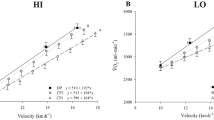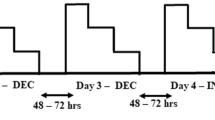Summary
This study compared the effects of 9 weeks of run (RT) versus cycle (CT) training on ventilatory threshold (Thv) determined during treadmill (TM) and cycle ergometer (CE) graded exercise testing. Sixteen college age men were assigned to a RT or CT group and performed a TM and a CE test before and after training. Both training groups performed similar training protocols which initially consisted of continuous exercise 4 days·week−1 at 75–80% maximum heart rate (fc,max) for 45 min. Training intensity was later increased to 80–85% fc max and interval training (90–95% fc,max) was incorporated 2 days·week−1 into the continuous training. Both groups showed significantly improved maximal oxygen consumption (\(\dot V\)O2max) on both TM and CE tests (P<0.01) with no significant differences between the groups. Significant Thv increases (P<0.05) were found on TM tests for RT (n=8) and CT (n=8) groups [mean (SD); 443 (438) and 373 (568) ml O2·min−1, respectively] with no difference between the groups. Results from the CE tests revealed a significant Thv increase (P<0.01) for the CT group [566 (663) ml O2·min−1] with no change for the RT group. The Thv improvement noted for the RT group was significantly different (P< 0.05) comparing CE with TM tests but not for the CT group. The results indicate that CT and RT improvement in Thv for runners is dependent upon mode of training and testing, and there is an apparent dissociation of \(\dot V\)O2maxand Thv specific to training.
Similar content being viewed by others
References
Beaver WL, Wasserman K, Whipp BJ (1986) A new method for detecting anaerobic threshold by gas exchange. J Appl Physiol 60:2020–2027
Boutcher SH, Seip RL, Hetzler RK, Pierce EF, Snead D, Weltman A (1989) The effects of specificity of training on rating of perceived exertion at the lactate threshold. Eur J Appl Physiol 59:365–369
Brooks GA (1985) Anaerobic threshold: review of the concept and directions for future research. Med Sci Sports Exerc 17:22–31
Conley D, Krahenburt G (1980) Running economy and distance running performance of highly trained athletes. Med Sci Sports Exerc 12:357–360
Davis JA (1985) Anaerobic threshold: review of the concept and directions for future research. Med Sci Sports Exerc 17:6–18
Davis JA, Frank MH, Whipp BJ, Wasserman K (1979) Anaerobic threshold alterations caused by endurance training in middle-aged men. J Appl Physiol 46:1039–1046
Denis C, Fouquet R, Poty P, Geyssant A, Lacour JR (1982) Effect of 40 weeks of endurance training on the anaerobic threshold. Int J Sports Med 3:208–214
Gaesser GA, Poole DC (1986) Lactate and ventilatory thresholds: disparity in time course of adaptations to training. J Appl Physiol 61:999–1004
Gaesser GA, Poole DC, Gardner BP (1984) Dissociation between \(\dot V\)O2max, and ventilatory threshold responses to endurance training. Eur J Appl Physiol 53:242–247
Henson LC, Poole DC Whipp BJ (1989) Fitness as a determinant of oxygen uptake response to constant-load exercise. Eur J Appl Physiol 59:21–28
Hill DW, Cureton KJ, Grisham SC, Collins MA (1987) Effect of training on rating of perceived exertion at the ventilatory threshold. Eur J Appl Physiol 56:206–211
Iwaoka K, Hatta H, Atomi Y, Miyashita M (1988) Lactate, respiratory compensation thresholds, and distance running performance in runners of both sexes. Int J Sports Med 9:306–309
Kumagai S, Tanaka K, Matsura Y, Matsuzaka A, Hirakoba K, Asano K (1982) Relationships of the anaerobic threshold with the 5 km, 10 km, and 10 mile races. Eur J Appl Physiol 49:13–23
Leger L, Thivierge M (1988) Heart rate monitors: validity, stability, and functionality. Phys Sportsmed 16:143–151
Olsen R, Berg K, Latin R, Blanke D (1988) Comparison of two intense interval training programs on maximum oxygen uptake and running performance. J Sports Med 28:158–164
Peronnet F, Thibault G, Rhodes EC, McKenzie DC (1987) Correlation between ventilatory threshold and endurance capability in marathon runners. Med Sci Sports Exerc 19:610615
Poole DC, Gaesser GA (1985) Response of ventilatory and lactate thresholds to continuous and interval training. J Appl Physiol 58:1115–1121
Powers SK, Dodd S, Deason R, Byrd R, McKnight T (1983) Ventilatory threshold, running economy, and distance running performance of trained athletes. Res Q Exerc Sport 54:179–182
Prud'homme D, Bouchard C, LeBlance C, Landry F, Lortie G, Boulay MR (1984) Reliability of assessments of ventilatory thresholds. J Sports Sci 2:13–24
Ready AE, Quinney HA (1982) Alterations in anaerobic threshold as a result of endurance training and detraining. Med Sci Sports Exerc 14:292–296
Reybrouck R, Ghesquiere J, Weymans M, Amery A (1986) Ventilatory threshold measurement to evaluate maximal endurance performance. Int J Sports Med 7:26–29
Roberts JA, Alspaugh JW (1972) Specificity of training effects resulting from programs of treadmill running and bicycle ergometer riding. Med Sci Sports 4:6–10
Vago P, Mercier J, Ramonatxo M, Prefaut CH (1987) Is ventilatory anaerobic threshold a good index of endurance capacity? Int J Sports Med 8:190–195
Walsh SD, Davis JA (1990) Noninvasive lactate threshold detection using V-slope method with non-breath-by-breath data. [Abstr]. Int J Sports Med 4:322
Withers RT, Sherman WM, Miller JM, Costill DL (1981) Specificity of the anaerobic threshold in endurance trained cyclists and runners. Eur J Appl Physiol 47:93–104
Author information
Authors and Affiliations
Rights and permissions
About this article
Cite this article
Hoffmann, J.J., Loy, S.F., Shapiro, B.I. et al. Specificity effects of run versus cycle training on ventilatory threshold. Europ. J. Appl. Physiol. 67, 43–47 (1993). https://doi.org/10.1007/BF00377703
Accepted:
Issue Date:
DOI: https://doi.org/10.1007/BF00377703




